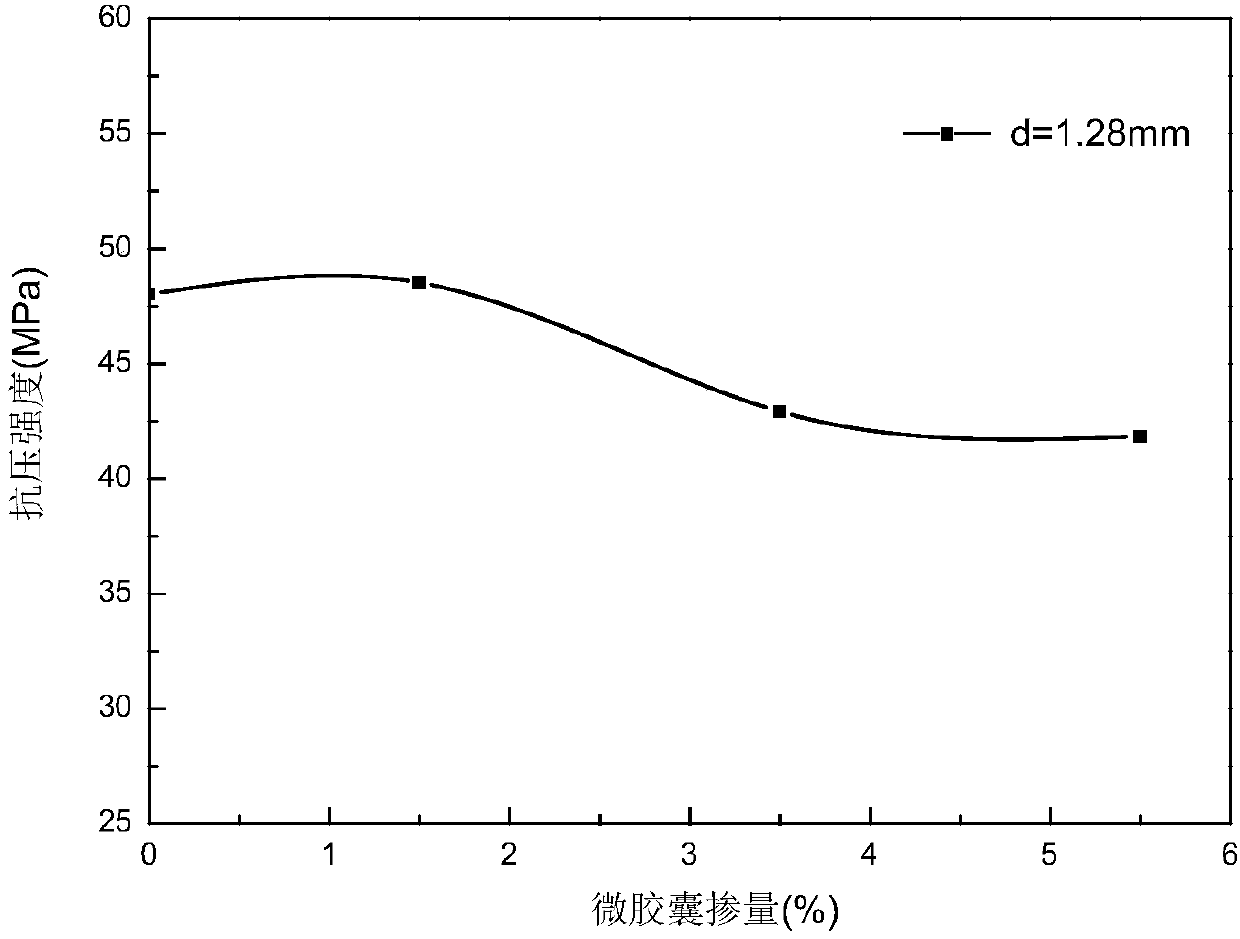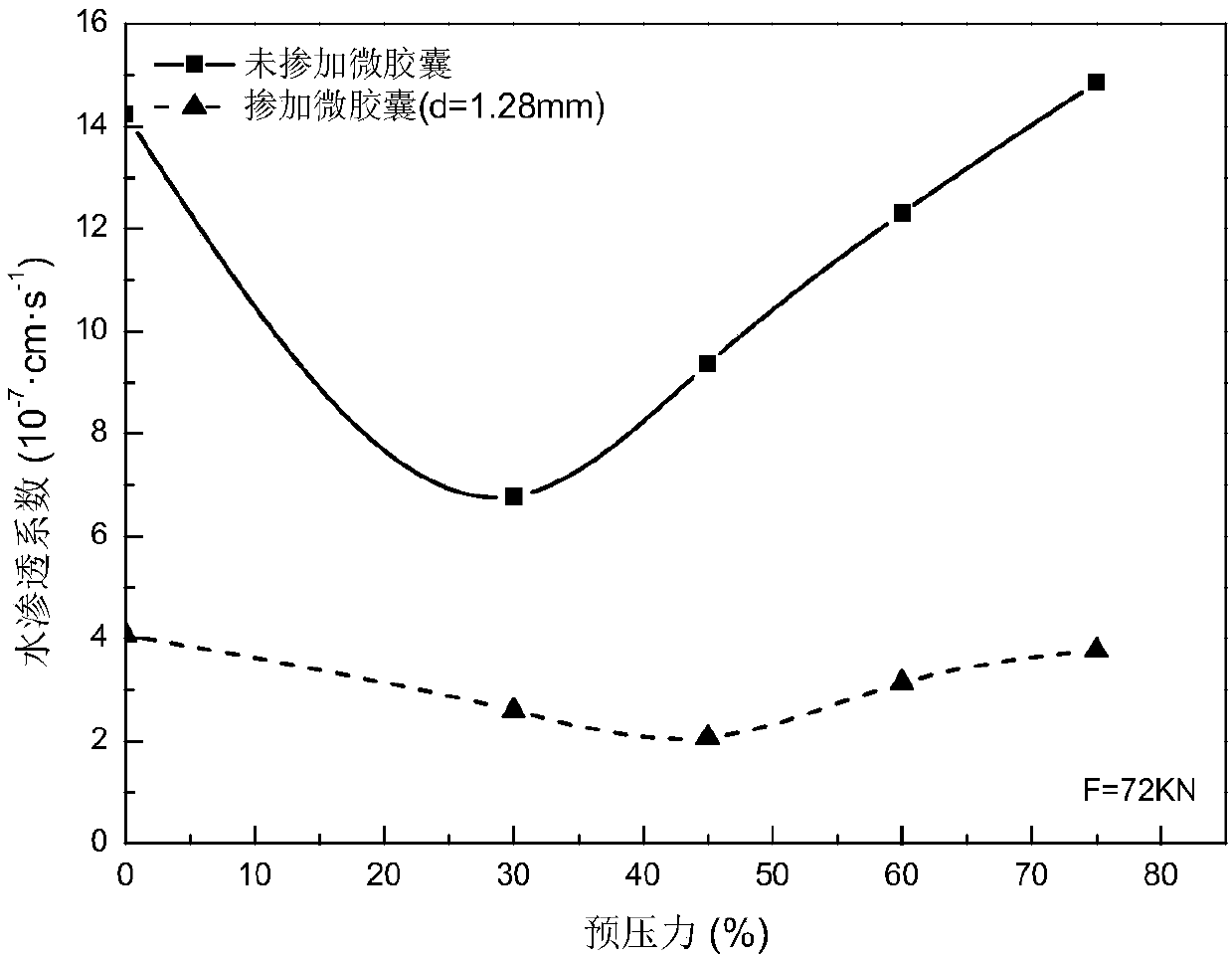Swelling type micro-capsule/cement-based self-repair system
A microcapsule and self-repairing technology, which is applied in the field of concrete shrinkage reduction and crack repair, can solve the problems of unreachable repair, complicated production process, and influence on popularization and application, and achieve the effect of not being easily broken and having good mechanical properties
- Summary
- Abstract
- Description
- Claims
- Application Information
AI Technical Summary
Problems solved by technology
Method used
Image
Examples
Embodiment 1
[0041] (1) Weigh 4.0 g of sodium alginate solid, add it to 250 mL of deionized water, and stir with a stirrer, and after the sodium alginate solid is completely dissolved, a 1.6 wt % sodium alginate solution is obtained;
[0042] In a water bath at 55°C, add the above-mentioned sodium alginate solution and 0.63 g of sodium dodecylbenzenesulfonate to the four-neck flask respectively, start the mechanical stirring device, and the emulsifier is formulated according to 0.25 wt% of the sodium alginate solution;
[0043] 20.0 g of E-51 bisphenol A epoxy resin was added thereto under stirring, stirred for 1.5 h at a stirring speed of 600 r / min, and an epoxy resin-sodium alginate mixed solution was obtained after cooling. The mass ratio of calcium alginate to epoxy resin is 1:5.
[0044] (2) Add the mixed solution obtained in step (1) into a disposable syringe, using a medical 25G needle;
[0045] Weigh 9.0g calcium chloride solid, add it into 300mL deionized water, after the calcium...
Embodiment 2
[0053] (1) Weigh 2.5g of sodium alginate solid, add it to 250mL deionized water, and stir with a stirrer, after the sodium alginate solid is completely dissolved, a 1.0wt% sodium alginate solution is obtained;
[0054] In a water bath at 65°C, add the above-mentioned sodium alginate solution and 0.38 g of sodium dodecylbenzenesulfonate to the four-neck flask respectively, start the mechanical stirring device, and the emulsifier is formulated according to 0.15 wt% of the sodium alginate solution;
[0055] 7.5g of E-51 bisphenol A epoxy resin was added thereto under stirring, stirred at a stirring speed of 600r / min for 1.5h, and an epoxy resin-sodium alginate mixed solution was obtained after cooling. The mass ratio of calcium alginate to epoxy resin is 1:3.
[0056] (2) Add the mixed solution obtained in step (1) into a 50mL disposable syringe, using a medical 21G needle;
[0057] Weigh 4.5g of calcium chloride solid and add it to 300mL of deionized water. After the calcium ch...
Embodiment 3
[0064] (1) Weigh 10.0 g of sodium alginate solid, add it to 250 mL of deionized water, and stir with a stirrer, and after the sodium alginate solid is completely dissolved, a 4.0 wt % sodium alginate solution is obtained;
[0065] In a water bath at 55°C, add the above-mentioned sodium alginate solution and 0.65 g of sodium dodecylbenzenesulfonate to the four-neck flask respectively, start the mechanical stirring device, and the emulsifier is formulated according to 0.25 wt% of the sodium alginate solution;
[0066] 40.0 g of E-51 bisphenol A epoxy resin was added thereto under stirring, stirred for 1.5 h at a stirring speed of 300 r / min, and an epoxy resin-sodium alginate mixed solution was obtained after cooling. The mass ratio of calcium alginate to epoxy resin is 1:4.
[0067] (2) Add the mixed solution obtained in step (1) into a 50mL disposable syringe, using a medical 30G needle;
[0068] Weigh 9.0g calcium chloride solid, add it into 300mL deionized water, after the c...
PUM
| Property | Measurement | Unit |
|---|---|---|
| The average particle size | aaaaa | aaaaa |
| The average particle size | aaaaa | aaaaa |
| The average particle size | aaaaa | aaaaa |
Abstract
Description
Claims
Application Information
 Login to View More
Login to View More - R&D
- Intellectual Property
- Life Sciences
- Materials
- Tech Scout
- Unparalleled Data Quality
- Higher Quality Content
- 60% Fewer Hallucinations
Browse by: Latest US Patents, China's latest patents, Technical Efficacy Thesaurus, Application Domain, Technology Topic, Popular Technical Reports.
© 2025 PatSnap. All rights reserved.Legal|Privacy policy|Modern Slavery Act Transparency Statement|Sitemap|About US| Contact US: help@patsnap.com



